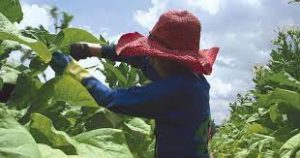
A 15-year-old girl works on a tobacco farm in North Carolina. July 2013. © 2013 Human Rights Watch
For whom does the bell toll? These days it tolls for our children, gunned down in our streets and schools because of gun violence. And as if this were not enough, there are the child laborers among us and the rollback of protections proposed by atavistic lawmakers. Child labor is not a thing of the past and it is on the rise.
Know Their Names
Just in late June and July of this year, three boys died while working on the job in violation of state and federal law. Duvan Thomas Perez, 16, died after being caught by a conveyor belt while cleaning machinery in a poultry processing plant. Michael Schuls, 16, died after being trapped under machinery at a logging company. Pinned between a trailer rig and its trailer, Will Hampton, also 16, died while working at a landfill.
According to the US Department of Labor (DOL), unlawful employment of children rose 37 percent in 2022, but an upward trend goes back as far as 2015. Of the 2022 reported cases, 688 children worked in hazardous working conditions. Some children were as young as 10 years old, worked up to 12 hours a day, and, unsurprisingly, did not attend school. In fact, the extent of violations far exceeds this reported number, as it covers only violations that inspectors uncover on infrequent inspections.
The high-profile cases recently uncovered were at sites included supply-chain facilities linked to Hyundai and Kia; meatpacking plants in Nebraska and Minnesota; and McDonald’s, Dunkin Donuts, and Chipotle locations. Children work in sanitation services and operate milking machines; some pre-teens were working as roofers in Florida and Tennessee.
From 300,000 to 500,000 minors also work in agriculture, and nearly half of worker fatalities in our fields are young workers.
Here in Illinois, in 2022 the state department of labor found child labor law violations in personal services, food, restaurants, consumer and commercial retail—and a health center!
The Chicago Workers Collaborative (CWC), a non-profit advocacy group, organized a March, 2022 protest rally in front of a Hearthside Food Solutions Factory in Bolingbrook, IL. Launched after an insider tip, a CWC investigation found children as young as 13 in the plant.
CWC is pushing for a Whistleblower Right of Action Law, given the recognition that the use of child labor is much higher than labor departments uncover. As the Hearthside case showed, whistleblowers are an important means of tightening enforcement and more accurately assessing the magnitude of child labor.
Why Not Make Things Worse?
Shockingly, Republican-controlled legislatures are determined to extend the assault on children. According to the Economic Policy Institute, rollbacks of child labor protections have been passed or introduced in at least 10 states. In Arkansas, for example, Governor Sarah Huckabee Sanders signed a bill removing requirements for employers to verify the age of children as young as 14 before hiring them. Wisconsin and Iowa lawmakers have proposed allowing 14-year-olds to serve liquor in bars and restaurants. In Iowa and Ohio, bills have been introduced to expand the hours minors can work during school days.
The assault on child labor protections goes back at least a decade. The Cato Institute, a right-wing think tank, released a document in 2014 arguing that existing child labor protections needed to be unraveled, as they stifled opportunity for the children of the poor. Think tanks associated with the wealthy De Vos family (think Trump’s former Labor Secretary, Betsy DeVos) and the Koch brothers have also held conferences and private discussions with legislators which identify their interest in undermining child labor laws.
The rationales put forward to support changes in protections range from the claim that poor families need the extra income derived from young family members to current labor shortages. In the first instance, the hypocrisy of proponents is exposed by the fact that their bills often dismiss requirements for parents to certify approval of a child’s particular work role or expanded work hours—taking the family out of the situation. As for labor shortages, the real issue is not so much the shortages per se as the fact that the shortages, if and where they exist in a particular industry, are putting pressure on employers to pay their adult workers more and increasing workers’ bargaining power and willingness to strike.
Publicly unstated, however, is right-wing interest in seeing the dismantling of the whole of labor protections. Providing the specific language to state legislators for their regressive bills, the Foundation for Government Accountability (FGA) seeks to dismantle all business regulations, as well as the federal government’s authority to pass and enforce such regulations. FGA’s goal aligns with those of other right-wing movers and shakers like the Kochs and DeVoses, as well as the politicians that carry water for them. Indeed, some analysts view the proliferation of laws rolling back child labor protections as part of an overall strategy. It is a strategy to trigger federal suits against the states that could ultimately lead to a case before the Supreme Court—one whose majority has already shown itself to be hostile to federal regulatory authority.
Finally, one may ask how in good conscience any right-wing strategy can pivot on an attack on vulnerable children. What makes it so easy for proponents to be so heartless, so compassionless? Do they not think of their own children? The obvious answer is that they need not be concerned about their own. Child laborers are more likely to come from poor and working-class, often Black, families. As recent newspaper headlines have exposed, they are also increasingly likely to be migrant children. Indeed, it is these children who are particularly prone to land among hazardous working conditions, especially in meatpacking and agriculture. In short, class, race, ethnicity, and citizenship status operate to stifle the moral sensibility of advocates of rollbacks.
Where to Go From Here?
One piece of good news is that fighting back against rollbacks can work. Public opposition has stalled such efforts in several states, and in Virginia, a sub-minimum wage bill for youth failed in the wake of public outrage.
We should not be offering resistance only, however. Moving from defensive to offensive advocacy is in order. Penalties for child labor-law violations should be increased, and underfunding at DOL should be rectified to allow for more on-site labor inspections.
Legislation to consider supporting includes bills that would protect whistleblowers who report child labor law violations. A federal bill to raise the minimum age for child farmworkers has been introduced and currently has the endorsement of more than 200 national, regional, and state groups.
Strengthening the rights of labor to organize through legislation like the PRO Act would also be extremely helpful. Unionization provides a means for “shop-floor enforcement,” meaning monitoring of violations of child labor laws can be offered daily and not just through DOL inspections. Unions can also afford protections to whistleblowers.
Setting these reforms against the proposed rollbacks clarify that the choice is up to us. Do we want to be a country that rejects the barbarism of exploiting the most vulnerable among us, or is there still room in America for the enlightened project of protecting today those who will become our future.

899 total views, 4 views today